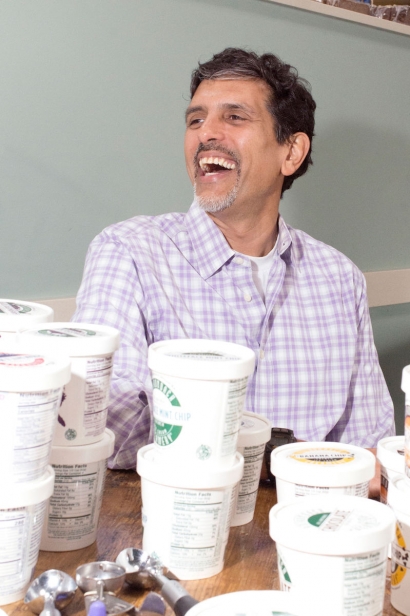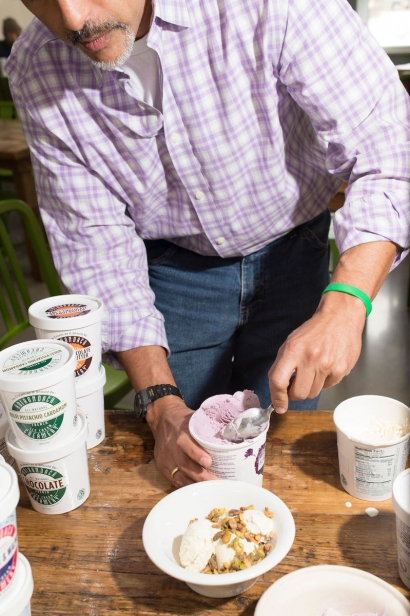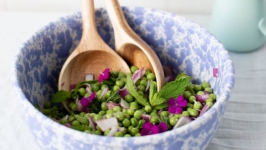Adirondack Creamery, An American Dream
Can you imagine wanting to do one thing for a living so badly, you decided to give up dating, move to the sticks and work multiple jobs to make ends meet? Then, when success finally beckoned almost a decade later, can you imagine dedicating a chunk of your proceeds to make a political point?
Seems extreme, but that’s what Paul Nasrani, the founder of farm-to-freezer Adirondack Creamery, did. Nasrani bristles with the energy and intensity of someone who has managed—against long odds—to make his dream a reality.
But before we dig into Nasrani’s scoop du jour, let’s hop into the wayback machine and figure out what inspired him to create a line of ice cream that serves as an edible analogy of America’s melting pot. (In the classic Americana corner, we have Vanilla and Chocolate, in the international corner we have Syrian Date & Walnut and Kulfi-Pistachio Cardamom, in the gray zone we have Earl’s Chocolate Peanut Butter and Banana Chip.)
Nasrani, like many Americans, embodies the vast strata of the immigrant experience in his one person. His mother’s ancestors arrived on the Mayflower in 1620, his father came here from the Punjab region in the 1960s, following India’s partition. And like many Americans, Nasrani indulged in the most rustic of American pursuits as a child: He spent his summers working on a farm near his home in northeastern Pennsylvania.
“The farmer, Earl Whitebread, opened his farm and his home to me,” recalls Nasrani, over coffee at Honest Weight Food Co-op in Albany, one of the Adirondack Creamery’s first significant commercial customers. “He made homemade ice cream, using as many products as he could from the farm. He didn’t have a formal recipe, but it was unlike anything I’d ever had before.”
Miles away in flavor and philosophy from the mass-market ice creams of his 1980s youth, this ice cream contained little more than Whitebread’s farm-raised cream, milk, egg yolks, plus sugar and wholesome flavors. No xanthan gum, corn syrup solids, polysorbate 80, mystery dyes or chemistry experiments in Whitebread’s pints. He decided, at Whitebread’s elbow, that he wanted to be an ice cream maker when he grew up.
In addition to spending his summers working at the farm, he and his family vacationed on Lake George, where old-fashioned ice cream, sans chemistry, was still a way of life. “Every night of the week when we were up there, my parents would let my sister and me get sundaes from a 100-yearold Silver Bay ice cream store,” he says. “Sitting there on hot evenings and digging into our sundaes with my family is one of my most cherished memories of childhood.”
As years passed, Nasrani continued to silently nurture his childhood dream, while implicitly acknowledging its impracticality by overtly pursuing other career paths. He’d become an ice cream maker when he retired, he told himself while studying accounting. By 30, he was the CFO of a mid-size legal services company. He was living the single life in New York City. No real complaints. Then 9/11 happened.
“I think everyone, but especially people in the city, took a harder look at their life choices after that,” he acknowledges. “I decided to revisit my love for making homemade ice cream in my tiny studio apartment. I had a Bloomingdale’s ice cream maker.” (Sheepish grin.)
It’s hard to recall a time during this century when artisanal ice cream, pickle and sausage makers weren’t valiantly competing for shelf space with corporate brands, but in 2002, the only ice cream folks churning out ice cream with “real” ingredients were Håagen-Daz and Ben & Jerry’s, Nasrani notes.
“So even though I was spending all of my free time making ice cream, I couldn’t keep up with the demands from my friends, family and co-workers,” he says. “They couldn’t get enough of it.”
Vacations became opportunities to expand his palate and working knowledge of the biz. “I would research ice cream manufacturing companies in areas where I was vacationing, and I’d just go up to places and knock on the door,” Nasrani says. “People were incredibly open and would share their process and give me tours of their facilities.”
He discovered that, across the board, ice cream manufacturers struggled to make their business viable if they prioritized using locally, sustainably produced ingredients. “The industry’s scale had shift ed so dramatically and farmers couldn’t really sell their milk unless they did it by trailer load, not a practical option for a studio apartment,” Nasrani says.
And then, one day, he noticed that a mom-and-pop ice cream shop he’d been frequenting in Grand Central Station was closing and they were going to auction off their equipment that Sunday.
An impractical, highly inadvisable plan, lacking the logistical framework he learned in accounting school, began to coalesce in the back of his mind. A brand new machine would have cost $30,000. He won the bid with $3,500, which he paid with $800 in cash (the maximum an ATM would give him) and an IOU, along with a promise to get it out of the space by Monday at 9 a.m.
“I hauled the machine out, in my suit, on my way to work,” Nasrani says.
“My friend in the furniture business lent me his truck, which I then sent to my other friend’s house in New Jersey, because I talked him into storing the equipment in his garage until I came up with a solid plan.”
Then, determined not to think too hard about the 401(k)-busting implications of his decision, he quit his job and talked the CEO of Silver Bay into letting him set up his fancy “new” machine to make all of the ice cream for the old stand he frequented as a child. This was 2003.
“Yeah,” he nods, “I decided I’d live a very simple life in Lake George. I’d live in a small room above the ice cream store, I wouldn’t date, and I’d just devote all of my spare time and savings to ice cream.”
Th ankfully, life stymied some of Nasrani’s more bleak plans.
“A friend introduced me to her former roommate, thinking we’d hit it off, but I knew a Manhattan lawyer would never want to date an ice cream maker living in upstate New York,” he says. But as it turns out, this woman named Simi had had it up to here with self-aggrandizing fi nance guys. Fortunately, she had an open mind and an appetite for ice cream. Twelve years of marriage and two children (Kalil, 10, and Tayel, 7) later, their union is clearly the cherry on top of Nasrani’s sundae.
“I can’t overstate the difference my wife’s support through this process made,” he says, acknowledging that even with her salary, he had to work almost full-time as a freelance financial consultant while also getting the business off the ground. Adirondack Creamery followed the slow, painful, stop-and-start pattern of growth so familiar to most small business owners.
“Simi lived at her mom’s summer place on Glen Lake while I made ice cream for the store,” he recalls. “But we realized, at a certain point, that we either had to take the next step with the business or fold.” He started looking at factories in the Hudson Valley, meeting with economic development boards, and exploring whether any banks would be willing to help fi nance a multi-million-dollar ice cream operation.
Then, he reached out to Rich Boice at Boice Brothers Dairy in Kingston about building a production facility at their location and discovered a weird problem they had. They’d ended up inheriting a bunch of ice creammaking equipment from a customer who went bankrupt. The dairy had no use for it, plus they didn’t know how to operate it. Nasrani suggested they team up, and although he didn’t have a clue how to work the machines or how to run an ice cream plant, he knew a good deal when he saw it.
As soon as the Boice family of five agreed, Nasrani immediately tapped his network of contacts for help. His mentor Earl Whitebread’s grandson, Jan Whitebread, it turned out, was a fabulous mechanic who would relish the opportunity of running an ice cream plant.
And they were off.
“The two of us did everything, from putting the ice cream in the pints, to labeling them, to distributing them,” he recalls. Eventually, Jan’s father, Duane, joined the party. At fi rst, they were producing 10 to 20 cases of ice cream a week. But as the public’s taste for artisanal, local, sustainable everything continued to build, so did their business. By 2009, Adirondack Creamery was in major regional stores like Honest Weight and Healthy Living, plus several outposts in New York City, including the paragon of all things delicious and local, Whole Foods.
Meanwhile, Nasrani’s commitment to using local ingredients had only deepened as he saw a deeper crisis in the dairy industry as a whole.
“Family dairy farmers in New York can’t compete with the national manufacturers,” he says.
“The price they get when they sell to co-ops or stores forces many of them to lose money just to stay in business. But because I’m willing to pay a premium for bulk, high-fat cream, some of the small dairy farmers are able to make ends meet by selling to me directly.”
In 2016, after another round of growing pains and an open discussion with the crew at Boice, they expanded to a plant in New York City and, later, to a family-run ice cream production facility in the western Adirondacks.
“That move enabled us to bump up our production to 500,000 pints a year, and allowed me to stop running the plant and focus on sales,” Nasrani says.
But 2016 also coincided with Donald Trump’s election, a development that so shocked Nasrani, he created ice creams to deal with it. “I’m not rich, I’m not powerful,” he says. “I make ice cream. So I do what I can with that.”
As the son of an immigrant, the plight of Syrian refugees captured his imagination. “One of the most American things you can do is take fl avors from afar and make it your own,” he says. “Food is a bridge between cultures.” Inspired by the Syrian dessert cookie ma’amoul (a buttery shortbread brimming with dates and walnuts), Syrian Date & Walnut debuted in 2017. Ma’amoul is more than a cookie; it’s a symbol. It is enjoyed by everyone in Syria: Muslims on Eid al-Fitr and Eid al-Adha, Christians on Christmas and Easter, and Jews on Rosh Hashanah and Hanukkah. Half the profi ts from sales of the fl avor go to the International Rescue Committee’s relief efforts. On the carton is the word “Peace,” in English, Arabic and Hebrew. The flavor (and the vibe) is almost savory, familiar yet foreign, with a honeyed sweetness that lingers.
Then there was the problem of partisanship. Black Raspberry had already been in production, but he repackaged it. “People think too much in terms of red and blue,” he says. “We need to remember that there’s more that unites us than divides us, so I’ve dedicated our Black Raspberry ice cream to that notion. Instead of seeing states as red and blue, let’s see them as purple, complex, distinct, with diff erent stories and dialects, but sharing a united vision of the beauty and greatness of America.” He introduced it just before the midterm elections in 2018. It’s selling like purple hotcakes.
Nasrani’s the guy living the inspirational quotes the rest of us are posting on Instagram, but that’s OK. We can drown our sorrows in a scoop of Syrian Date & Walnut, and know that, for the price of a pint, we’re supporting refugees, farmers and childhood dreams.
Adirondack Creamery | @adirondackcreamery
Honest Weight Food Co-op | @honestweightfoodcoop
Healthy Living Market & Café | @healthylivingnewyork








